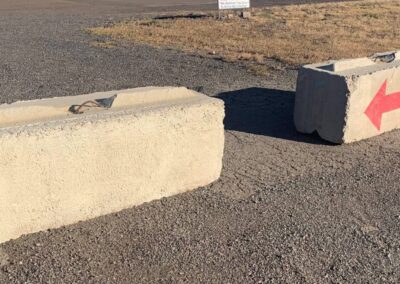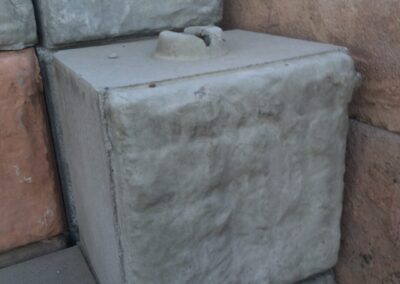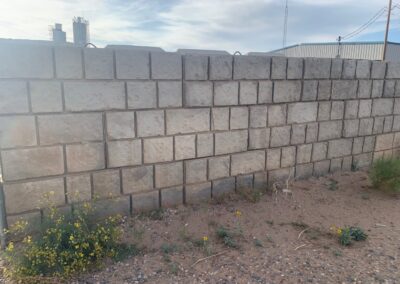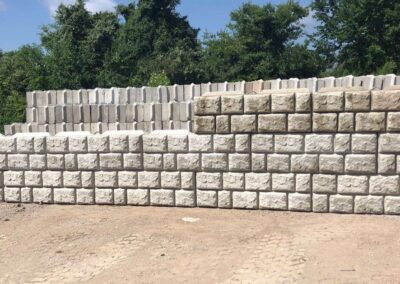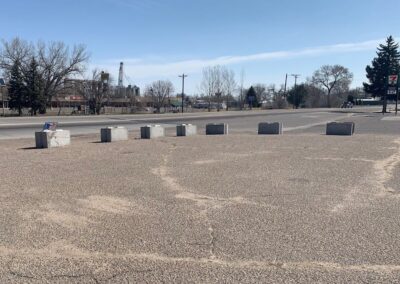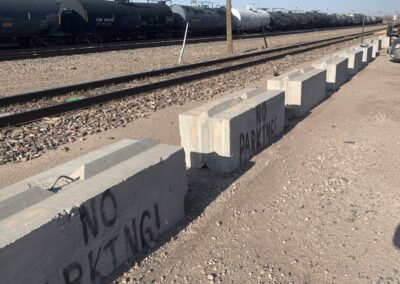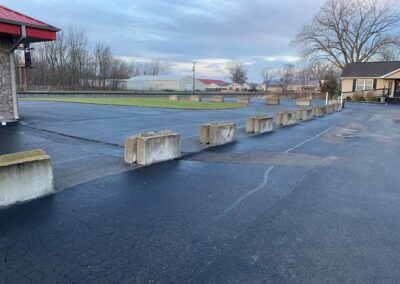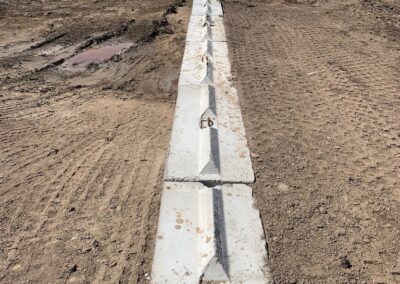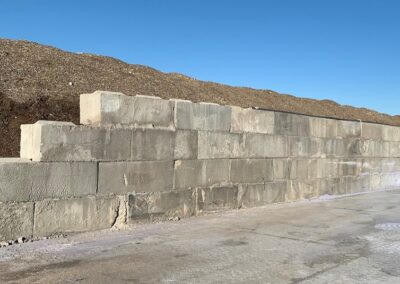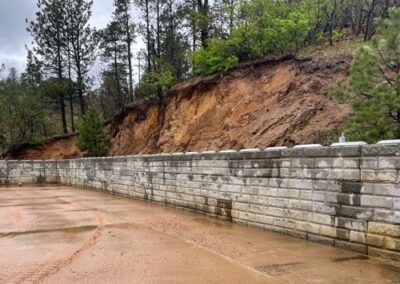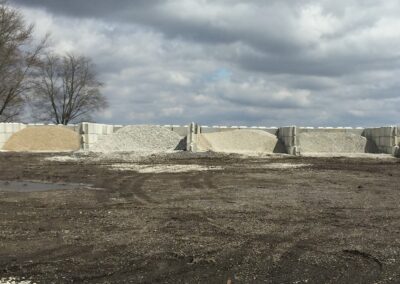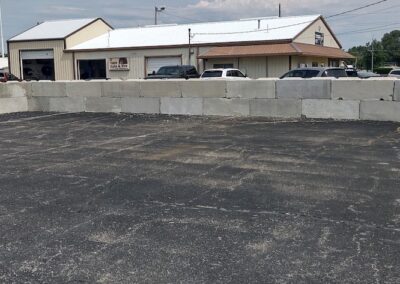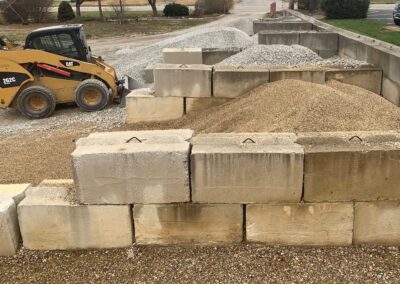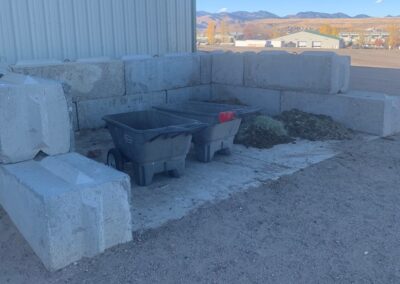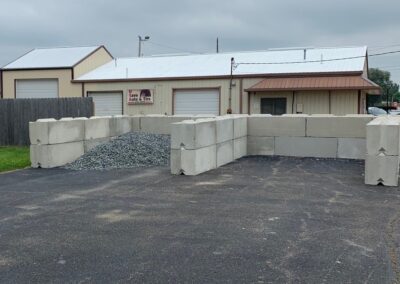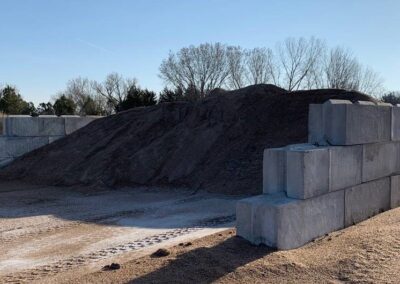Products
Get Your Free Quote Today
The most available block style is what we call the V-wedge. The full sized V-wedge blocks is 6’L x 2’W x 2’H (3,600 lbs). It has a V-wedge on the top and one side. The bottom and other side have a reverse V-wedge so that the blocks can interlock. There is a rebar handle loop on the top to be used for picking up the block. This block style can also be available in 4’L x 2’W x 2’H (2,400 lbs) and 3’L x 2’W x 2’H (1,800 lbs). 13 full sized blocks can fit per flat bed delivery.
The other block style is what we call lego blocks. The full sized lego blocks are 5’L x 2.5’H x 2.5’L (4,700 lbs) They have a two “lego” cylinders on top and two “holes” in the bottom for the blocks to interlock. There is a rebar handle loop on the top to be used for picking up the block. This block style can also be available in 2.5’H x 2.5’L x 2.5’H (2,350 lbs) 9 full sized blocks can fit per flat bed delivery.
Most of blocks available have a plain façade but a few locations offer decorative façades. The facades can vary between: slate, random rock, river rock, and brick. Please reach out to a sales representative to find out what is available in your area.
BIN BLOCKS: YOU MAY HAVE HEARD THEM CALLED BY ANOTHER NAME.
The most unique thing about bin blocks is that each person and/or region uses different names for them. The most popular names are bin blocks, mafia blocks, barrier blocks, large concrete blocks, interlocking v-blocks, lego blocks, ecology blocks, gravity wall blocks, waste blocks, storage wall blocks, bunker blocks, jumbo blocks and left-over concrete block.
IF YOU ARE LOOKING FOR A HEAVY OBJECT THAT CANNOT BE EASILY MOVED, THEN YOU ARE LOOKING IN THE RIGHT PLACE.
In many applications, bin blocks are a much more cost-effective substitute for highway, or jersey barriers. On personal property, these large concrete blocks are a great, cheap method to divert traffic. Whether placing bin blocks in areas along property to prevent unwanted people from parking there, putting them in front of a driveway to prevent people from using it, or surrounding parking lots to protect patrons dining outdoors from vehicles, concrete blocks are the most cost-effective concrete method there is. Weighing 3,600 lbs or 4,700 lbs, they are not something people with bad intentions simply get out of their vehicle and move around by hand, making them a very effective solution to any parking or other traffic issues you may be experiencing.
One popular inquiry has been to buy something to prevent thieves from driving through the garage doors of facilities. Several business owners have called in a rush to buy barriers because they were paying security to sit at their buildings until the blocks were set in place.
There are plenty more traffic-diverting uses for bin blocks that have not been specifically mentioned here, which is why concrete bin blocks remain the most cost-effective concrete method there is.
For a small price you can decrease your liability, and save yourself time and money protecting your property without necessarily having 24 hour a day monitoring.
Customers frequently call to buy highway barriers, but after speaking with a representative about intended use, typically decide to use bin blocks instead. Highway, or Jersey, barriers sell from between $600 to $800, whereas large concrete blocks are typically available under $200.
RETAINING WALL INFORMATION
A very popular use of precast concrete retaining wall blocks is to use them to form a cost effective retaining wall. At 6´L x 2’W x 2’H and 3500lbs or 5’L x 2.5’W x 2.5’H and 4,700lbs they make quick work of building a retaining wall. This type of retaining wall type is called a gravity wall because they use their own weight to hold the soil behind them. The first step is to measure out how long of an area by how high of an area you need to form your wall. Most flatbed trucks can ship 13 (6’x 2’x 2’blocks) or 9 (5’x 2.5’x 2.5’ blocks) at a time so any multiple of 13 or 9 will get you the best bang for your buck if you want the blocks delivered. You will begin by leveling out the area for your first row of blocks. Set your first row, making sure each block is firmly set and level. Once you set your first row the second row and beyond will go much faster. It is recommended that you offset the blocks so that the joints do not line up, this will offer you more strength at the joint. Most people only going a few blocks high and choose not to use any type of geofabric because the weight of the large retaining wall blocks is enough to hold back the soil. Depending on your specific application and how high you are making your retaining wall you may want to put a mesh fabric in between your block row to offer your wall more resistance against the soil. This is up to you as Concrete Block Supply provides blocks and not engineered walls. Another thing to possibly consider is drainage. A layer of rock or gravel 8¨ – 12¨ works well. If you have a lot of moisture or a taller wall you may also need to install drainage pipe. In most areas the large retaining wall blocks are simply plain with a standard concrete finish, but in a few areas the blocks are offered with a brick or slate finish for a more ascetically appealing wall finish. Please keep in mind in all instances these retaining wall blocks are poured with extra concrete, they are not perfectly finished, which is why they are not $350+ each. The large retaining wall blocks Concrete Block Supply provides are the most cost-effective way to build a retaining wall but they are not the perfect fit for all applications.

